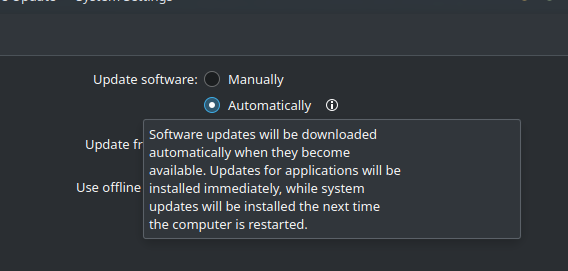#1 is just not being the default for 99% of devices. If someone gets a new computer, why would they go through the effort of installing a new os when the one it comes with works fine? Hell, I bet at least 50% of people in the market for a pc don’t even know what an OS is.
Agreed. Android and chrome os are used happily by 10s of millions without any idea it’s a Linux distro
I bet if small, cheap netbooks came out running mint or fedora or something people wouldn’t even or know or care that it was Linux.
In middle school I had a USB drive with Linux Mint installed on it which I was using on school PCs. We only used those PCs for internet browsing and office. Not a single soul noticed it wasn’t Windows. Teacher only noticed 2 differences, “You have different version of Office installed here.” and also gave me a note for “Changing wallpaper” which was strictly prohibited for some reason.
which was strictly prohibited
It was probably due to some goober like me changing it to Scarlett Johansson’s bikini pics. I’m sorry.
deleted by creator
Absolutely. In fact i think everyone is hoping steam os will be the distro to make the big push onto desktop because of the gaming and another just works kind of interface
…the steamdeck isn’t a netbook.
Indeed, many Netbooks come with a firmware dual boot. Besides the crappy Windows lite edition, there’s a tiny instant-on Linux too. Most people don’t use that, but it’s there.
Indeed, many Netbooks come with a firmware dual boot. Besides the crappy Windows lite edition, there’s a tiny instant-on Linux too. Most people don’t use that, but it’s there.
Which actually means Linux is being successfully adopted by the general public in a similar way to windows as a general use system that doesn’t require a lot of technical knowledge.
Fully customizable distress will never be popular with the general public. They want systems that just do the general stuff and have it work automatically.
Of course they know what an OS is. There’s only two of them: Apple and Microsoft.
my first thought actually pointed to common OS on work devices, being Windows i’d assume a majority of the time, i’d imagine a large portion of the older population were introduced to computers in a workplace setting. But your answer makes a bit more sense.
I bet at least 50% of people in the market for a pc don’t even know what an OS is.
70%*
- Isn’t pre-installed on well known machines by well known brands.
- Popular applications (whether productivity, creativity, or games) do not work out of the box that people want. It doesn’t matter that alternatives exist, or that you can use things like Wine. If it’s more than just click the icon, it’s too much.
- If things cannot be done purely through touch / the mouse, it is too hard for most people.
If things cannot be done purely through touch / the mouse, it is too hard for most people.
100%. Even as a power-user (understatement) who overwhelmingly prefers keyboard input to control things when I’m “gettin’ stuff done”, I will sometimes miss the general consideration level of Windows’ input handling when it comes to mouse and especially touch. Mouse is pretty damn good these days on Linux, but touch…
Touch is abysmal. A ton of modern laptops have touchscreens, or are actually 2-in-1s that fold into tablets, etc, and the support is just barely there, if at all. I’m not talking about driver support - this is often fairly acceptable. My laptop’s touch and pen interface worked right out of the box… technically. But KDE Plasma 5 with Wayland- an allegedly very modern desktop stack- is not pleasant when I fold into tablet mode.
The sole (seriously, I’ve looked) Wayland on-screen-keyboard, Maliit, is just terrible. No settings of any kind (there is a settings button! it is not wired to anything, it does nothing), no language options, no layout options (the default layout is abysmal and lacks any ‘functional’ keys like arrows, pgup/dn, home/end, delete, F keys, tab, etc), and most egregiously, it resists being manually summoned which is terrible because it does not summon itself at appropriate times. Firefox is invisible to it. KRunner is invisible to it. The application search bar is invisible to it. It will happily pop up when I tap into Konsole, but it’s totally useless as it is completely devoid of vital keys. Touch on Wayland is absolutely pointless.
Of course, there is a diverse ecosystem of virtual keyboards and such on Xorg! However, Xorg performance across all applications is typically abysmal (below 1FPS) if the screen is rotated at all. This is evidently a well known issue that I doubt will ever be fixed.
In the spirit of Open Source Software, and knowing that simply complaining loudly has little benefit for anyone, I have at several times channeled my frustration towards developing a reasonable Wayland virtual keyboard, but it’s a daunting project fraught with serious problems and I have little free-time, so it’s barely left its infancy in my dev folder, and in the meanwhile I reluctantly just flip my keyboard back around on the couch with a sigh, briefly envious of my friend’s extremely-touch-capable Windows 2-in-1.
I echo your frustrations with Maalit. I am running Arch on my Surface Pro 7 and very frequently I have to snap in the keyboard just to get myself out of a situation where touch doesn’t work. Maalit also has this bug where it will push and resize windows as if it was visible even though it is hidden.
Regarding the Firefox issue, it helps if you enable it’s Wayland backend by passing MOZ_ENABLE_WAYLAND=1 to it. Maalit should properly pop whenever you tap on a text box.
MOZ_ENABLE_WAYLAND=1
Thank you - I was already aware of this, actually, but I choose to leave it disabled because when this is set, touchscreen drag-scrolling of webpages breaks and it selects text as though it were a mouse click-drag instead. As it turns out, I barely use Maliit anyway because of its other deficiencies, but I definitely touch-scroll my browser a lot, even in laptop mode. A generally disappointing dilemma!
I also had this problem where touch scrolling on Firefox selects text instead (on ubuntu). It does however work OOTB for me on fedora, so it’s the main distro on that machine.
I agree with the touchscreen thing-- I have one of those foldy-aroundy 2-in-1 laptops, and the only way I’ve been able to get touch to work properly (as in not like a mouse) is gnome wayland. Kde wayland’s fine too, but like you said there’s no included keyboard whereas gnome has one built-in. Also another wayland osk you could try is wvkbd (tho I’ve never used it beyond “hey what’s this”).
GNOME has amazing touchscreen gestures, and afaik comes with it’s own virtual keyboard
I have been tempted by GNOME several times, but I disagree with some of their design choices and find them a bit frustrating. I feel that it’s fairly strongly-opinionated software. The benefits, of course, are obvious: internal consistency that leads to a higher quality experience. But, only if you buy-in to some overarching design philosophy. That’s one of the reasons I left Windows! I also have a suite of Kwin scripts that make my life a lot easier, so it’s pretty hard to leave Plasma at this point.
Still, that keyboard has tempted me a lot nonetheless…
Me too. I love the look of Adwaita, but some of their choices I can’t get past, like not having a system tray. I’m really excited for Cosmic, it looks like it will blend the styling of GNOME with much of KDE’s customization!
While this is true, if someone goes to a shop and buys a “PC”, it will have Windows 100% of the time.
You have to look to get Linux preinstalled on stuff, or pick the choice yourself. People buying PCs aren’t picking Windows, it’s just what comes with them.
Preinstalled.
Like, were nerds and we fuck with our computers n stuff. But most people are lucky to know what a power cord is.
Honestly if Linux with a good DE like KDE or Cinnamon was already on their PC at boot they would figure it out. Most people just use a web browser anyways.
This is definitely how I feel as well. None of the other shit matters unless it comes already on the machine. Even then, it absolutely has to be rock solid stable long term for it to be comparative. Of course that’s asking a lot, considering people still take their PCs into geek squad or wherever else when something goes wrong (or their printer won’t connect).
This always reminds me of the Dell XPS option of having Ubuntu installed but of course that’s far away from “Microsoft literally pays us to sell their shit”. So, until that - or some type of adoption occurs on a B&M level/online-storefront - it’s going to be pretty “voluntary” in terms of adoption. It’s just comparatively so much more work in the layman’s sense.
It’s in a weird way the same with cars. It’s been statistically proven that most people specifically won’t go out of their way to get a simple utility pickup truck. They buy the big fuck you truck because that’s what the dealerships have. It’s the same thing with kids going to college and the parents taking them to buy a laptop for class. My point is that it’s far more easier to just use what you get than try to rehash it. Maybe you don’t even know that’s a possibility so you just settle. Of course this isn’t the only issue, but imo the largest determining factor. IBM had businesses sucking from the teet since computers dropped, and we still deal with the ramifications.
I have put my dad on Kubuntu. Don’t like anything *buntu, personally, but I have to admit it’s quite stable and with sane defaults. He hasn’t complained ever since and support calls dropped considerably. He spends most of the time in Firefox anyways, where I’ve added ublock.
The problem with Windows was, he’d occasionally browse the web with Edge by mistake (or because MS forces it down your throat), and as soon as an 80+ y.o. browses the web without ad blocking, getting a virus is just a matter of time.
All this is to say that I agree with the fact that preinstalled is key. I wish that more effort was focused on fewer distros and I feel that so much talent and energies are being lost in marginal projects.
But many people do this for passion and it’s of course their choice to decide where to contribute, or whether to spin up a brand new distro entirely, can’t judge them for that. I’m just observing that those energies could be better used to smoothen some rough edges on more popular distros to make them even more appealing to OEMs and convince them to ship those on their hardware.
Most people buy computers with the OS already installed and would get just as lost trying to install MacOS or Windows.
This is the correct answer. If Linux was pre-installed, most problems would vanish. My Linux computers are far, far more stable than windows once they run.
The pre installation also means the OEM will verify compatibility, a common complaint.
- All of the basics should just work well out of the box with minimal tweaking. Yes even NVIDIA stuff.
- The software center needs a massive overhaul. It feels like an afterthought by people who would rather use a command line.
Yeah, the descriptions and lack of curation is really weird … browse games and oh look here’s 27 varieties of reversi and a driving game that crashes on launch.
If it were a curated list with enthusiastic and helpful descriptions it would make it more accessible to use. Get the mature and professional looking programs front and center.
Much as I hate to say it, it could do with a makeover from someone with a sense of marketing. (Excuse me for a second, I felt a little nauseous saying that).
Im not sure the software center being half baked is even the real problem.
One of the nice things about Windows is that you dont need a central, curated, repository for software. You can google the thing you want and just download an msi/exe of the latest stable version and, 99.9% of the time, leading back to your first point, it will just work.
What? That is easiest one of the worst parts of windows. It’s just that people are used to this dumb endeavour
It needs to “just work”. It’s not more complicated than that.
This, a lot of ppl talk about the pre installed thing but Linux has a lot of friction yet. Linux is big, it’s open and made to run in almost any device with an arm or x86 processor, yet Linux is usually a pain in the ass on edge cases and we cannot ignore. Some years ago dealing with drivers on Linux was a hell, today is better but still has edge cases (this is not a Linux fault usually, vendors are shit usually but it cause friction. Audio just recently was resolved with the adoption of pipewire but pulseaudio had a lot of caveats. Now we are getting rid of X11 that is great for usual usecases but is full of workarounds if you want to to a simple thing like having two monitors with different refresh rates. There is a lot of things but linux is going forward, last year I could made my full switch since gaming on Linux became a thing but definitely was not plug and play.
deleted by creator
Yeah honestly same, I hate having to sudo into random system files to change something basic or having to open a terminal and remember the specific magic words to do what I need
so whenever I have the option I use GUI over CLI every time
This is heavily influenced by choice of DE. Some of them really do have all their options well laid out in the system settings, but others rely entirely on config files. I have little experience with GNOME, but with KDE I was able to customize my experience very heavily using only the system settings by just playing around in the GUI. Meanwhile, on another machine running Hyprland, I have had to read a lot of documentation in order to customize it, but the available options are relatively more powerful than the KDE setup.
Neither of these methods are more right than the other, but one is absolutely more new-user friendly, assuming they do not want to simply accept the defaults.
Speaking from experience, from a long time ago, and from the people/family I’ve installed it for on older machines: It’s different. That’s 90% of it.
The people that had little to no windows/PC experience actually took to Linux a lot easier not having to relearn/change habits from windows.
Correct. It’s lack of familiarity. Once Linux gets around 10-15% market share, enough people who know the quirks of Linux to help new people who then Linux will be big.
- Self updating without user interaction per default.
- Better support of codecs and drivers.
Linux does have better codecs and drivers than Windows for some stuff (Bluetooth for example), but it has worse codecs and drivers for some important proprietary hardware stuff (Nvidia for example)
Self updating without user interaction per default.
I think that this is a terrible idea, until a clear boundary is set between applications that can or cannot break the system. Updating flatpaks automatically might be fine, but updating everything is simply a recipe for disaster.
deleted by creator
See, that paragraph alone is too much for the majority of non-Linux users.
i believe fedora has this by default

The actual answer, there is no reason to switch. The vast majority of users do not care about Linux or why they would want to. For us there are lots of benefits and things we enjoy about getting away from Windows but for them “why?”
I will object on this one. Even if the majority of user does not care about privacy they do care about ransomware , viruses, speed of the system and in my opinion Linux / BSD is secure, fast and speed remains after time not like Windows where I felt that after 6 months I had to reinstall to get a performant system. I guess it is all about convincing your family and friends about those benefits.
Two weeks ago my step mother asked me “Can you help my friend connect her PC to the wifi, it runs Windows XP” users are fucking weird.
New user: I have a problem 😊
Everyone:👍
- are you on xorg or wayland?
- pulseaudio or pipewire?
- what WM/DE are you using?
- amd or nvidia?
- what distro?
- systemd?
New user: Nevermind 😮💨
if a new user is using a distro that doesn’t use systemd they fell for a meme
if a new user is using a distro that doesn’t use systemd they fell for a meme
Or they hate fridge art like systemd and are on something like PCLinuxOS or Alpine.
That’s what I mean though, why would a new user be running alpine as a desktop os?
That would be me: My hardware at the time was crap so I couldn’t use the usual mint, ubuntu, etc and I was gonna use debian but I couldn’t find the x86 download button, so after a bunch of messing about with distros like puppy and #!++, I settled on alpine for a bit. I now have decent hardware and use fedora.
Doing tech support, I encountered this attitude. People like that are nearly impossible to help. “Why can’t you just fix it!” The true answer never given is that your problem is probably something stupid you are doing, like trying to make a phone call by physically shoving the phone entirely up your asshole, and until I run through some common problems and ask some questions, I won’t be able to tell you to have your significant other get the salad tongs and pull it out of your rear and then go over “dialing.”
People mostly need to be willing to gather detailed system info with Inxi and share it.
I’ll have you know I get better reception when it’s up my ass!
No. That’s the support job to figure out the problem of the user. It is not the user’s job to figure out the support problems.
I work in support, so I know what I’m talking about. Unfortunately most computer guys are elitist assholes who can’t understand a user doesn’t have their knowledge or even the will to understand why this shitty tech is not working.
Free open source software projects you don’t pay for don’t have paid support. If you talk to a fellow user it IS your job to figure out your problem. if you don’t have the will to understand anything you ought to buy a support contract.
I don’t disagree with you, but to answer OP’s question, I think this right here is the problem. I love Linux for the same reason I love building my own PCs and working on my own car. For most people that don’t want to tinker, though, they’re looking for something that “just works” and can be fixed by someone else when it breaks.
It’s such a privileged attitude, though. One CAN get paid support, but they don’t need it if they’re just a bit patient and willing to follow instructions. If you don’t want to pay, don’t expect someone else to deal with your bullshit.
(I’m not saying this to you, but to anyone who has this attitude.)
It case the subject wasn’t entirely clear in my prior post I agree with you, and that is exactly what I was trying to say. You the user of a foss project, aren’t a customer unless you give someone money. It IS your job to figure out your own issues. If you ask for help from your fellow users and they graciously provide you help then this is a gift you should appreciate. Because the person isn’t an expert on that topic in the employ of the creator, they might not know everything, nor do they have the infinite patience imparted by being paid by the hour to provide you help. They have their own shit to do. Treating them with entitlement and contempt like people treat support will burn these sorts of folks out, and they are far from an infinite resource. If you want a paid support relationship instead of treating the open source community as free help whose time you are entitled to, you ought to actually pay someone to do that job.
Pay for support then. Companies like Canonical and Redhat will be happy to take your money.
At this point, my biggest dream is that these ‘new user’ distros used only Wayland, Pipewire, Systemd and Flatpaks simply to simplify things. Hopefully we’re less than 2024 away from NoVideo Wayland support.
Also as soon as XFCE releases their Wayland support, that soon it’ll become the most famous DE choice of Mint.
What I am really happy is to see how well supported Pipewire already is. Pipewire has never showed any problem in the new installs for me.
The problem with that is most major distros market themselves as “new user” distros to some extent though. Noob-friendly, out-of-the-box, easy, etc are all distro-marketing buzz-words that mean nothing.
You can’t expect them to only use Wayland, Pipewire, Systemd, and Flatpaks because that dream requires every distro to use Wayland, Pipewire, Systemd, and Flatpaks, which will never be reality.
Most distros will probably eventually adopt these tools, but there won’t be a sudden shift. It will be gradual.
Well, for Pipewire it’s the apps which needs to adjust at this point. Only thing missing currently is the Wayland but it’s coming. Making Linux less fragmented (read: confusing), the more new users will give a try.
Why don’t you magically have a magic button that magically fixes everything with no effort of my own? That’s stupid, I think I will go on social media and repeatedly tell everyone that Linux is bad actually
So you want them to provide answers by using magic? If you seek support for any software, open source or otherwise, you’ll need to tell them version, build number etc. Why do you think Linux will be any different?
Because people can already barely provide this level of information for a Windows device. Most of these words look like technobabble to non-tech-enthusiasts
Of course the words will be different. They aren’t hard words. And they can be answered very easily. In fact, most forums ask to include an output of something like
inxi -Fazywith every question, thus eliminating the need for all of these things.For more niche problems, people might ask for more specific information. But most of the time, they’ll tell you exactly what to run to get that information.
You know what’s the Windows alternative for this? Most of the time, nothing. You need to reinstall Windows. Mac is similar, except you need to have it replaced. You actually CAN repair Linux. That’s the difference.
- Installation process of Linux is complicated to an average Joe (Bootable USB/ISO file/Boot priority/format <- what are these scary terms?)
- Lack of availability of pre-installed Linux PCs at physical shops
- Lack of availability of industry-standard software
- Confusion for an average Joe due to excess choice of distros/application packaging format. Average people don’t want choices, they want to be guided.
- (Minor point) Most available guides for doing something heavily requires terminal usage which can be daunting to new users
It’s the first step of installation, making a bootable usb/CD. Most non-technical people can’t be arsed to create a bootable drive, then go into the bios boot settings to run it. I haven’t used Windows in a long time so I don’t know how it’s installed these days, but the fact that it comes installed out-of-the-box when people buy a computer lets them skip the first and biggest step to running linux, which is getting it installed in the first place.
Distros have come a long way that a Windows user trying Linux Mint can hit the ground running. It’s no longer about the learning curve for USING linux, it’s INSTALLING linux that’s the problem.
Exactly. I’d argue that some supposedly mainstream distros are hard to install even for the competent. Last time I checked, Debian’s funnel for newbies consisted of a 90s-era website with “instructions” in the form of a rambling block of jargon-filled text with mentions of “CD-Roms” and a vague discussion of third-party apps for burning ISOs. I mean, on Linux flashing a USB stick is matter of a single
ddcommand with some obscure switches, but even that was nowhere to be found and I had to search forums for it. Incredible! Hard to imagine how forbidding it must all seem to the average Windows user! No Debian for them!IIRC Ubuntu’s process was much easier but still not as easy-peasy as it could have been.
The only hope for desktop Linux is a crystal-clear, bulletproof, 1-2-3-style onboarding funnel that takes the user from “this is the distro’s website” to “I have a bootable USB”. From that point on it’s plain sailing.
Whats nice about gnome is the disk util. included: select USB stick, click restore image and browse for the iso file. click OK.
As somebody who likes using the terminal I too have mostly stopped using
ddand use gnome disks instead. Getting the rightddflags to get the best performance and progress indicators is a challenge to Google every time.Yeah but here we’re interested in how easy this is for a normie on Windows.
- This is the distro website. Click on Download.
- Install Balena Etcher. This is the website. Now install it.
- Open Balena Etcher. Follow instructions on screen. Make sure you select the corrent iso file and the correct device (your USB of choice). Wait for the magic to happen… you have a bootable USB
Did not know Balena Etcher. Looks good - 1, 2, 3, professional-looking site.
But IMO even this is too involved. After all, by comparison, installing Windows is “Step 1. It’s done!”
Let’s say I know nothing about, say, Ubuntu, except that a techie friend told me to “have a go, it’s easy!” Well, personally I am going to want Ubuntu to do everything. I should not need to download stuff from random third-party sites that my friend never mentioned.
Basically, IMO there needs to be a FOSS clone of this Balena Etcher tool, which all the distros can rebrand and reskin as necessary. Then step 1 of “Install” is a native experience, just it is on the corporate OSes.
Maybe one of the slicker distros already does it, perhaps Pop_OS. If so, they deserve all the new users.
For Fedora, there is Fedora Media Writer. Maybe other distros can follow in its footsteps
Indeed. I just checked and IMO Fedora is doing it exactly right: a big button “Get started” with the Media Writer as step 1. Now this is Linux for dummies! Meanwhile on the supposed dummy distro Ubuntu.com, you get “Follow this tutorial” and a stodgy bunch of howtos. And Debian all but screams “go away if you’re not a nerd” 😭
A long time ago, Ubuntu actually had a interesting way to install Ubuntu on your PC through Windows. It was called “Wubi” if I remember right.
It was definitely… Odd in how it worked. I believe it created a Windows virtual disk image, stored that image on your Windows filesystem, and then added an entry into the Windows Boot Loader to somehow boot into that. On first boot, it was like Windows where it asked you to create an account and then boom - all done.
And if you no longer wanted Ubuntu, you could just literally uninstall it from the Windows “Add or Remove Programs” menu and it’d remove the boot loader entry, and delete the virtual disk image.
Super super new user friendly. Unfortunately I think the reason why it was discontinued was there was an I/O performance cost from running it in a virtual image - and of course just as it sounds, it was a hacky way to do things. And of course, you couldn’t get rid of Windows because Ubuntu was living inside it.
Reminds me of how nowadays I believe Asahi Linux for M1 PCs is installed from within macOS - you don’t need to create a boot USB and load it at startup.
Ha! Amazing, had no idea. Maybe that explains Ubuntu’s early success. But yeah, in the grand strategy, better not to settle for being a Windows .exe app
Indeed. And I think more distros, like Mint, should take this approach.
Yeah, it took me way too long to get Debian running on my pc, because for some reason the website assumed that everyone would have a Linux to install Debain with. I haven’t had that, and that one tool they had didn’t work.
This is exactly what I never get. Do they not know that when you buy a new computer it tends to have Windows and only Windows on it?! I can’t help concluding that the people who run Debian must be bearded nerds who live in PC-filled basements and assume that all their users are the same.
Most folks have been sold a story that every new technology they start using is supposed to be “intuitive”; and that if it is not “intuitive” then it must be defective or willfully perverse.
For example, novice programmers often stumble when learning their second or third language, because it differs from their first. Maybe it uses indentation instead of curly braces; maybe type declarations are written in a different order; maybe it doesn’t put
on its variables; maybe capitalization of identifiers is syntactically significant.And so they declare that Python is not “intuitive” because it doesn’t look like C; or Go is not “intuitive” because it doesn’t feel like PHP.
It should be obvious that this has nothing to do with intuition, and everything to do with familiarity and comfort-level.
Commercial, consumer-oriented technology has leaned heavily into the “intuitive” illusion. On an iPhone or Windows, Android or Mac, you’re supposed to be able to just guess how to do things without ever having to confront unfamiliarity. You might use a search engine to find a how-to document with screenshots — but you’re not supposed to have to learn new concepts or anything. That would be hard.
That’s not how to learn, though. To learn, you need to get into unfamiliar things, recognize that they are unfamiliar, and then become familiar with them.
Comfort-level is also important. It sucks to be doing experimental risky things on the computer that’s storing your only copy of your master’s thesis research. If you want to try installing a new OS, it sure helps if you can experiment with it in a way that doesn’t put any of your “real work” at risk. That can be on a spare computer, or booting from a USB drive, or just having all your “real work” backed up on Dropbox or Google Drive or somewhere that your experimentation can’t possibly break it.
It should be obvious that this has nothing to do with intuition, and everything to do with familiarity and comfort-level.
Not to be petty, but I think that intuitive is not that different to familiar.
I mean, the problem is in using the word intuitive when “selling” something in the first place. User interaction involves ton of things, large and small, and the intuitive things are rarely noticed. Such promise is likely going to lead to disappointment.
Adapting to these small differences is a skill in itself.
A lot of people have already talked about the onboarding/installation experience, so I’ll just chime in and say a lot of new users are unfamiliar with using a terminal for commands and instead favour a GUI experience solely for their tasks. Most modern and commercially appealing distros are moving in this direction (ie applications running the same terminal commands in the background with an easy to understand UI at the front) but I’d still say the community’s insistence on terminal over all other forms of executing a command may be a turn off for the layman trying it for the first time after Windows and MacOS.
Almost makes me think it would be more ideal to reduce the stigma associated with executing commands in the terminal and find some way to get people more comfortable with using it, both via Linux and also CMD for Windows as well.
I would agree that this is one of the biggest barriers to entry other than software compatibility.
If i was able to use ILok on linux for my music plugins and vsts, then id likely make the switch. But unfortunately ILok doesnt seem to be interested at least not since i last checked.
I agree with this more than trying to make Linux more GUI oriented overall. GUI’s are great for certain interfaces like phones and tablets for obvious reasons. GUIs are also great if you don’t exactly know what you’re looking for and need a lengthy list of available interactive elements you would have to read and parse a lengthy man page to find in the terminal.
Honestly I think that when learning computers in early age education systems, the terminal should be taught alongside GUI applications so the general public would have an understanding that there is this very powerful tool they can use to quickly execute commands. It is a pre requisite to demystifying computers regardless of which OS you use, and it makes working with your computer a lot less of a headache when you have this bare bones tool that can assist you in finding out the answer to your problem via a verbose error output rather than a cryptic message to call your sys admin or send a notice to the OS provider that likely will not solve your problem in a timely manner.

























